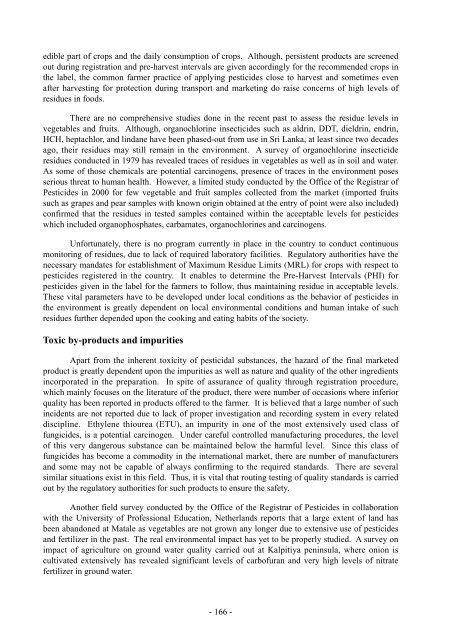Proceedings of the Asia regional workshop on the
Proceedings of the Asia regional workshop on the
Proceedings of the Asia regional workshop on the
You also want an ePaper? Increase the reach of your titles
YUMPU automatically turns print PDFs into web optimized ePapers that Google loves.
edible part <str<strong>on</strong>g>of</str<strong>on</strong>g> crops and <str<strong>on</strong>g>the</str<strong>on</strong>g> daily c<strong>on</strong>sumpti<strong>on</strong> <str<strong>on</strong>g>of</str<strong>on</strong>g> crops. Although, persistent products are screened<br />
out during registrati<strong>on</strong> and pre-harvest intervals are given accordingly for <str<strong>on</strong>g>the</str<strong>on</strong>g> recommended crops in<br />
<str<strong>on</strong>g>the</str<strong>on</strong>g> label, <str<strong>on</strong>g>the</str<strong>on</strong>g> comm<strong>on</strong> farmer practice <str<strong>on</strong>g>of</str<strong>on</strong>g> applying pesticides close to harvest and sometimes even<br />
after harvesting for protecti<strong>on</strong> during transport and marketing do raise c<strong>on</strong>cerns <str<strong>on</strong>g>of</str<strong>on</strong>g> high levels <str<strong>on</strong>g>of</str<strong>on</strong>g><br />
residues in foods.<br />
There are no comprehensive studies d<strong>on</strong>e in <str<strong>on</strong>g>the</str<strong>on</strong>g> recent past to assess <str<strong>on</strong>g>the</str<strong>on</strong>g> residue levels in<br />
vegetables and fruits. Although, organochlorine insecticides such as aldrin, DDT, dieldrin, endrin,<br />
HCH, heptachlor, and lindane have been phased-out from use in Sri Lanka, at least since two decades<br />
ago, <str<strong>on</strong>g>the</str<strong>on</strong>g>ir residues may still remain in <str<strong>on</strong>g>the</str<strong>on</strong>g> envir<strong>on</strong>ment. A survey <str<strong>on</strong>g>of</str<strong>on</strong>g> organochlorine insecticide<br />
residues c<strong>on</strong>ducted in 1979 has revealed traces <str<strong>on</strong>g>of</str<strong>on</strong>g> residues in vegetables as well as in soil and water.<br />
As some <str<strong>on</strong>g>of</str<strong>on</strong>g> those chemicals are potential carcinogens, presence <str<strong>on</strong>g>of</str<strong>on</strong>g> traces in <str<strong>on</strong>g>the</str<strong>on</strong>g> envir<strong>on</strong>ment poses<br />
serious threat to human health. However, a limited study c<strong>on</strong>ducted by <str<strong>on</strong>g>the</str<strong>on</strong>g> Office <str<strong>on</strong>g>of</str<strong>on</strong>g> <str<strong>on</strong>g>the</str<strong>on</strong>g> Registrar <str<strong>on</strong>g>of</str<strong>on</strong>g><br />
Pesticides in 2000 for few vegetable and fruit samples collected from <str<strong>on</strong>g>the</str<strong>on</strong>g> market (imported fruits<br />
such as grapes and pear samples with known origin obtained at <str<strong>on</strong>g>the</str<strong>on</strong>g> entry <str<strong>on</strong>g>of</str<strong>on</strong>g> point were also included)<br />
c<strong>on</strong>firmed that <str<strong>on</strong>g>the</str<strong>on</strong>g> residues in tested samples c<strong>on</strong>tained within <str<strong>on</strong>g>the</str<strong>on</strong>g> acceptable levels for pesticides<br />
which included organophosphates, carbamates, organochlorines and carcinogens.<br />
Unfortunately, <str<strong>on</strong>g>the</str<strong>on</strong>g>re is no program currently in place in <str<strong>on</strong>g>the</str<strong>on</strong>g> country to c<strong>on</strong>duct c<strong>on</strong>tinuous<br />
m<strong>on</strong>itoring <str<strong>on</strong>g>of</str<strong>on</strong>g> residues, due to lack <str<strong>on</strong>g>of</str<strong>on</strong>g> required laboratory facilities. Regulatory authorities have <str<strong>on</strong>g>the</str<strong>on</strong>g><br />
necessary mandates for establishment <str<strong>on</strong>g>of</str<strong>on</strong>g> Maximum Residue Limits (MRL) for crops with respect to<br />
pesticides registered in <str<strong>on</strong>g>the</str<strong>on</strong>g> country. It enables to determine <str<strong>on</strong>g>the</str<strong>on</strong>g> Pre-Harvest Intervals (PHI) for<br />
pesticides given in <str<strong>on</strong>g>the</str<strong>on</strong>g> label for <str<strong>on</strong>g>the</str<strong>on</strong>g> farmers to follow, thus maintaining residue in acceptable levels.<br />
These vital parameters have to be developed under local c<strong>on</strong>diti<strong>on</strong>s as <str<strong>on</strong>g>the</str<strong>on</strong>g> behavior <str<strong>on</strong>g>of</str<strong>on</strong>g> pesticides in<br />
<str<strong>on</strong>g>the</str<strong>on</strong>g> envir<strong>on</strong>ment is greatly dependent <strong>on</strong> local envir<strong>on</strong>mental c<strong>on</strong>diti<strong>on</strong>s and human intake <str<strong>on</strong>g>of</str<strong>on</strong>g> such<br />
residues fur<str<strong>on</strong>g>the</str<strong>on</strong>g>r depended up<strong>on</strong> <str<strong>on</strong>g>the</str<strong>on</strong>g> cooking and eating habits <str<strong>on</strong>g>of</str<strong>on</strong>g> <str<strong>on</strong>g>the</str<strong>on</strong>g> society.<br />
Toxic by-products and impurities<br />
Apart from <str<strong>on</strong>g>the</str<strong>on</strong>g> inherent toxicity <str<strong>on</strong>g>of</str<strong>on</strong>g> pesticidal substances, <str<strong>on</strong>g>the</str<strong>on</strong>g> hazard <str<strong>on</strong>g>of</str<strong>on</strong>g> <str<strong>on</strong>g>the</str<strong>on</strong>g> final marketed<br />
product is greatly dependent up<strong>on</strong> <str<strong>on</strong>g>the</str<strong>on</strong>g> impurities as well as nature and quality <str<strong>on</strong>g>of</str<strong>on</strong>g> <str<strong>on</strong>g>the</str<strong>on</strong>g> o<str<strong>on</strong>g>the</str<strong>on</strong>g>r ingredients<br />
incorporated in <str<strong>on</strong>g>the</str<strong>on</strong>g> preparati<strong>on</strong>. In spite <str<strong>on</strong>g>of</str<strong>on</strong>g> assurance <str<strong>on</strong>g>of</str<strong>on</strong>g> quality through registrati<strong>on</strong> procedure,<br />
which mainly focuses <strong>on</strong> <str<strong>on</strong>g>the</str<strong>on</strong>g> literature <str<strong>on</strong>g>of</str<strong>on</strong>g> <str<strong>on</strong>g>the</str<strong>on</strong>g> product, <str<strong>on</strong>g>the</str<strong>on</strong>g>re were number <str<strong>on</strong>g>of</str<strong>on</strong>g> occasi<strong>on</strong>s where inferior<br />
quality has been reported in products <str<strong>on</strong>g>of</str<strong>on</strong>g>fered to <str<strong>on</strong>g>the</str<strong>on</strong>g> farmer. It is believed that a large number <str<strong>on</strong>g>of</str<strong>on</strong>g> such<br />
incidents are not reported due to lack <str<strong>on</strong>g>of</str<strong>on</strong>g> proper investigati<strong>on</strong> and recording system in every related<br />
discipline. Ethylene thiourea (ETU), an impurity in <strong>on</strong>e <str<strong>on</strong>g>of</str<strong>on</strong>g> <str<strong>on</strong>g>the</str<strong>on</strong>g> most extensively used class <str<strong>on</strong>g>of</str<strong>on</strong>g><br />
fungicides, is a potential carcinogen. Under careful c<strong>on</strong>trolled manufacturing procedures, <str<strong>on</strong>g>the</str<strong>on</strong>g> level<br />
<str<strong>on</strong>g>of</str<strong>on</strong>g> this very dangerous substance can be maintained below <str<strong>on</strong>g>the</str<strong>on</strong>g> harmful level. Since this class <str<strong>on</strong>g>of</str<strong>on</strong>g><br />
fungicides has become a commodity in <str<strong>on</strong>g>the</str<strong>on</strong>g> internati<strong>on</strong>al market, <str<strong>on</strong>g>the</str<strong>on</strong>g>re are number <str<strong>on</strong>g>of</str<strong>on</strong>g> manufacturers<br />
and some may not be capable <str<strong>on</strong>g>of</str<strong>on</strong>g> always c<strong>on</strong>firming to <str<strong>on</strong>g>the</str<strong>on</strong>g> required standards. There are several<br />
similar situati<strong>on</strong>s exist in this field. Thus, it is vital that routing testing <str<strong>on</strong>g>of</str<strong>on</strong>g> quality standards is carried<br />
out by <str<strong>on</strong>g>the</str<strong>on</strong>g> regulatory authorities for such products to ensure <str<strong>on</strong>g>the</str<strong>on</strong>g> safety.<br />
Ano<str<strong>on</strong>g>the</str<strong>on</strong>g>r field survey c<strong>on</strong>ducted by <str<strong>on</strong>g>the</str<strong>on</strong>g> Office <str<strong>on</strong>g>of</str<strong>on</strong>g> <str<strong>on</strong>g>the</str<strong>on</strong>g> Registrar <str<strong>on</strong>g>of</str<strong>on</strong>g> Pesticides in collaborati<strong>on</strong><br />
with <str<strong>on</strong>g>the</str<strong>on</strong>g> University <str<strong>on</strong>g>of</str<strong>on</strong>g> Pr<str<strong>on</strong>g>of</str<strong>on</strong>g>essi<strong>on</strong>al Educati<strong>on</strong>, Ne<str<strong>on</strong>g>the</str<strong>on</strong>g>rlands reports that a large extent <str<strong>on</strong>g>of</str<strong>on</strong>g> land has<br />
been aband<strong>on</strong>ed at Matale as vegetables are not grown any l<strong>on</strong>ger due to extensive use <str<strong>on</strong>g>of</str<strong>on</strong>g> pesticides<br />
and fertilizer in <str<strong>on</strong>g>the</str<strong>on</strong>g> past. The real envir<strong>on</strong>mental impact has yet to be properly studied. A survey <strong>on</strong><br />
impact <str<strong>on</strong>g>of</str<strong>on</strong>g> agriculture <strong>on</strong> ground water quality carried out at Kalpitiya peninsula, where <strong>on</strong>i<strong>on</strong> is<br />
cultivated extensively has revealed significant levels <str<strong>on</strong>g>of</str<strong>on</strong>g> carb<str<strong>on</strong>g>of</str<strong>on</strong>g>uran and very high levels <str<strong>on</strong>g>of</str<strong>on</strong>g> nitrate<br />
fertilizer in ground water.<br />
- 166 -

















